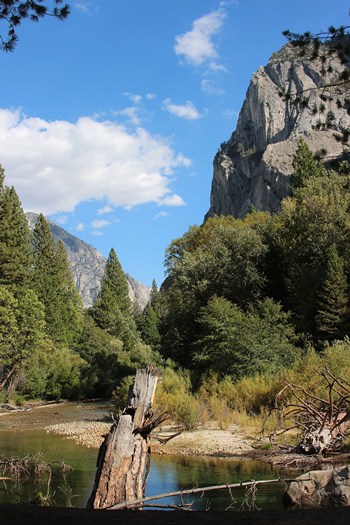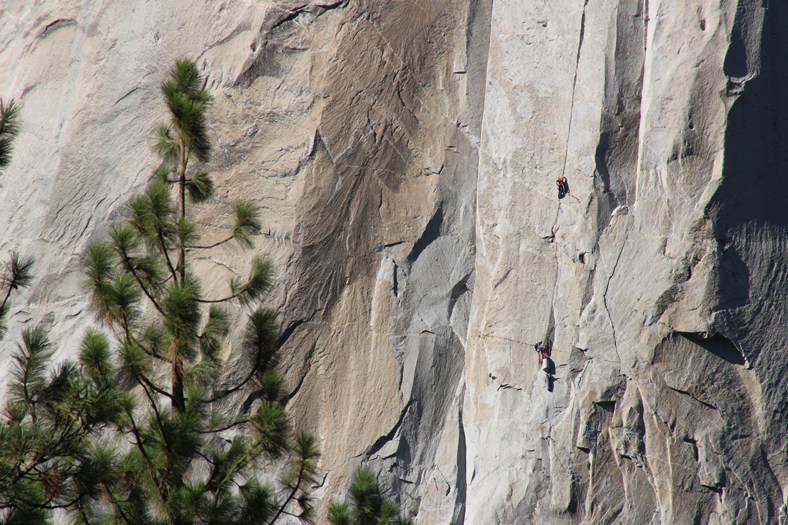YOSEMITE, CA - How do you sing Happy Birthday to a tree? Lots of people will be doing just that this year as three of America’s most beautiful national parks, all located in California, celebrated important anniversaries in 2015. Yosemite, one of the most visited national parks in the world, along with its state cousin, Sequoia, both turn 125 this year while Kings Canyon, another natural beauty, will celebrate its 75th birthday in 2015.
Dare we say it: All three are truly getting batter with age!
Magical is the best description of these massive parks nestled in the shadow of California’s dramatic High Sierra mountains, where the landscape is dominated by groves of giant sequoias and meadows of minuscule wildflowers that stretch out as far as the eye can see.
Centrally located (a four-and-one-half hour drive to one of the parks from Los Angeles or San Francisco), the parks are equidistant from southern and northern California and best seen on the Majestic Mountain Loop, the 800-kilometres Sierra Circle that connects Yosemite to Kings Canyon to Sequoia.
So leave yourself lots of time because this is one drive that’s well worth the effort.
Here’s a rundown on each park:
YOSEMITE
First established with the Yosemite Grant Act by president Abraham Lincoln, noted as California’s first national park and named a World Heritage Site, it is considered one of the best of the country’s 59 national parks— distinctive companions include Yellowstone and the Grand Canyon.
Though Yosemite is the approximate size of Rhode Island, its stats include superlatives: a ski resort (California’s first), two glaciers; countless waterfalls (including North America’s highest and the world’s fifth highest), 3,000 meadows, 37 species of native trees, 1,450 wildflower species, more than 250 types of birds and 90 mammal species (including its star attraction, between 300 to 500 black bears).


Left:The majesty of national parks in the United States can Right: The mighty Sequoias rule Grant Cove.
Seasonal details include spring’s blooming Pacific dogwoods and California redbuds with waterfalls and rivers at their peak, the busy activity of people and animals in summer, autumn’s colourful palette with warm days and cool nights and winter’s snow and solitude.
But it is the park’s Big Three — El Capitan, Half Dome and Yosemite Falls — that are Yosemite’s prime draws and the four-plus million visitors the park attracted in 2014 can attest to that.
As the world’s biggest piece of granite — three Empire State Buildings could stack almost to the top of El Capitan — the mighty mountain is obviously a draw for climbers who come from all over the globe to conquer the giant monolith, which provides endless excitement for “spectator” sporters perched in El Capitan Meadow with binoculars watching climbers scale the peak’s sheer face. The average climb is between four to six days; the record was two hours and 20 minutes. Its most noted challenge was completed on January 14, 2015 — the first free climb of Dawn Wall, made in just19 days.
Half Dome is a Yosemite icon. Rising nearly 1,500 metres above Yosemite Valley, it dominates most valley views and its 30 kilometre round trip trek is an additional Yosemite challenge.
Yosemite Falls, North America’s tallest waterfall, consists of three sections: Upper Yosemite Falls, Middle Cascades and Lower Yosemite Falls. Its prime-time for viewing is spring, with peak runoff typically between May and June.
An adventure playground with alpine attitude, activities in Yosemite and its immediate environs include ziplining in Mariposa, river rafting on the Merced River and an introduction to climbing at Yosemite Mountaineering School.
KINGS CANYON
Though Kings Canyon National Park is the least visited of the three parks, noted naturalist John Muir deemed it “a rival to Yosemite.” At 461,901 acres, it is home to one of the nation’s deepest canyons (maximum depth, nearly 8,000 feet). The best way to experience the park is via Kings Canyon Scenic Byway. This 60-kilometre scenic drive from the forests of Grant Grove travels along a steep descent to the vast panorama at Kings Canyon Overlook, where the South Fork of the Kings River meets the road and follows it all the way down to the quiet setting of Cedar Grove and Road’s End, deep in the heart of the canyon.

Left: Climbers look like ants as they scale the sheer rock face of mighty El Capitan in lovely Yosemite.
At Road’s End is the serenity of Zumwalt Meadow, a scenic open setting surrounded by forest and towering mountains. Muir Rock is nearby. A massive, oversized riverbed boulder, it’s where John Muir, founder of the Sierra Club, took fellow members of the environmentally-conscious organization during their Kings Canyon visit.
By reversing course and returning to Grant Grove Village, you’ll find the General Grant’s Grove section, a showcase of sequoias. Its premier habitant is General Grant, one of earth’s largest trees. Found halfway around the grove’s paved loop, president Calvin Coolidge named it “The Nation’s Christmas Tree” in 1926.
Kings River and Sequoia National Parks share a boundary. Between both parks, nature’s amenities include more than over 1,600 kilometres of marked trails; 331 native mammals, birds, fish, reptiles and amphibians; over 1,551 species of plants and 275 caves. All of the above attract more than 1.5 million annual visitors.
SEQUOIA
Sequoia National Park (404,063 acres) was California’s second national park. Known for its giant eponymous trees, scattered about the park are all-things sequoia.
The Parker Group is considered one of the finest clusters of sequoias reachable by automobile. Tunnel Log is a fallen sequoia that was tunnelled from one side to the other and is now the only “tree you can drive through” in these parks. And Giant Forest is the home to General Sherman Tree, estimated to be more than 2,000 years old.
For a 360-degree view of the western half of Sequoia National Park, a climb to the top of Moro Rock is mandatory — approximately 400 steps to its summit.
Yosemite, Kings Canyon and Sequoia — a virtuoso performance by Mother Nature. In summation, while superlatives seem inadequate, I defer to John Muir: “Going to the mountains is going home.
About the Author
Cynthia is a journalist and admitted addict — a travel addict. As a travel writer whose office is the world, she’s visited seven continents, 60 countries, countless cities and innumerable countrysides, where she’s attempted Argentina’s tango, canoed in the Amazon, ridden a Harley-Davidson throughMelbourne and sat amongst penguins in Antarctica. Born a Texan, she’s a long-time San Diego resident. In addition to TraveLife, credits include Time Magazine (Europe and Asia editions), Hemispheres, Costco Connection, Shape, Fit, Destinations Weddings & Honeymoons, and numerous newspapers. She also hosted the “No Passport Required” show on World Talk Radio and authored the book, “Get Your Travel Writing Published” (McGraw-Hill is the US/Canada distributor). Go to http://www.travelingcynthia.blogspot.com to see Cynthia's blog.